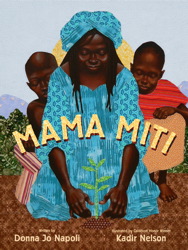March 5 - Today's post contributed by Mary Ann Scheuer and Louise Capizzio
Pass the Band-Aid Please!
Introducing children to Clara Barton, founder of the American Red Cross
The publication of Patricia Polacco’s Clara and Davie (Scholastic, 2014) offers an opportunity to introduce Clara Barton, founder of the American Red Cross. Children will be drawn into Clara’s story, but Polacco focuses on Barton’s childhood. We would like to suggest ways to pair this picture book with more traditional nonfiction sources to give children a fuller picture of Barton’s remarkable life.
We are both youth librarians passionate about sharing engaging nonfiction with children. Mary Ann is a school librarian in a California elementary school. Louise is a youth services manager in a public library in Maine. We hope to share this as an example of one way school and public librarians support each other, sharing titles to further enhance the book options for curious minds.
Mary Ann: Patricia Polacco, one of my favorite authors, draws readers right into Clara and Davie by helping them identify with Clara. One of Polacco’s special gifts as an artist is to connect with her readers because of her ability to convey so many emotions, both in her artwork and her storytelling. Like Polacco herself, Clara was painfully shy as a child and often teased. She found safety and comfort in animals on her farm, often treating them when they were hurt.
“She seemed to have healing in her hands. When Clara was helping animals, her heart sang. She felt brave and confident with critters.”
When her beloved brother Davie was dreadfully hurt falling off the barn roof, Clara tended to him day after day, determined to help him heal, seeing to his wounds and providing comfort and encouragement. My students were fascinated by the historical context of this story, especially how much medical treatment has changed since the 19th century.
Polacco provides only a little information about Barton’s later achievements. She writes in the author’s note, “Clara Barton grew up to become one of the greatest healers and medical practitioners of her time.” Because I want to help my students understand these achievements more fully, I turned to Louise to help recommend other sources for us to explore.
Louise: Introducing Clara Barton to students is exciting because it is a perfect opportunity to reinforce research skills. As always, the best place to start is with a biography. Start elementary students with an overview of Barton’s life and accomplishments: Clara Barton: angel of the battlefield, by the editors of Time for Kids with Anna Prokos. Students will like the clear text and helpful sidebars, with information on topics like “Women’s Rights in the 1800s” and “Civil War Medicine”.
Coming out July 2014 in the very popular Who Was series is Who Was Clara Barton? by Stephanie Spinner. The series is consistent in providing basic information about the subject by incorporating facts and interesting anecdotes in an easy to read text. Sidebars on related materials, a timeline and the black and white illustrations make this series useful for those students who are transitioning into more complex text.
Unfortunately, there are few biographies for an older audience still in print. Hopefully, this will change with the publication of Clara and Davie.
Mary Ann: For older students, visit the National Parks Service website for the Clara Barton National Historic Site in Maryland. They have a Virtual Museum Exhibit, with information from Barton’s life and primary source materials to explore. They even have lesson plans for teachers -- of particular interested is the lesson on Clara Barton that focuses on how she broke boundaries and traditions. Take a look at this interesting Civil War News Souvenir Card from 1863.
Louise: To round out the learning experience, watch and listen to a mini-biography from Biography.com that highlights Barton’s career and accomplishments. Often a video can grab kids’ attention.
Mary Ann Scheuer is an elementary school librarian in Berkeley, CA and writes the blog Great Kid Books. You can also find her on Twitter at @MaryAnnScheuer.
Louise Capizzo is the youth services manager in a public library in Maine and writes the blog The Nonfiction Detectives, along with Cathy Potter. You can also find Louise on Twitter at @Lcapizzo.






























